
The King's Royal Rifle Corps was an infantry rifle regiment of the British Army that was originally raised in British North America as the Royal American Regiment during the phase of the Seven Years' War in North America known as 'The French and Indian War.' Subsequently numbered the 60th Regiment of Foot, the regiment served for more than 200 years throughout the British Empire. In 1958, the regiment joined the Oxfordshire and Buckinghamshire Light Infantry and the Rifle Brigade in the Green Jackets Brigade and in 1966 the three regiments were formally amalgamated to become the Royal Green Jackets. The KRRC became the 2nd Battalion, Royal Green Jackets. On the disbandment of the 1st Battalion, Royal Green Jackets in 1992, the RGJ's KRRC battalion was redesignated as the 1st Battalion, Royal Green Jackets, eventually becoming 2nd Battalion, The Rifles in 2007.

The Artists Rifles is a regiment of the British Army Reserve. Raised in London in 1859 as a volunteer light infantry unit, the regiment saw active service during the Second Boer War and the First World War, earning a number of battle honours. It did not serve outside Britain during the Second World War, as it was used as an officer training unit at that time. The regiment was disbanded in 1945, but in 1947 it was re-established to resurrect the Special Air Service Regiment. Today, the full title of the regiment is 21 Special Air Service Regiment (Artists) (Reserve) and with 23 Special Air Service Regiment (Reserve), it forms the Special Air Service (Reserve) part of the United Kingdom Special Forces (UKSF).

The Post Office Rifles was a unit of the British Army, first formed in 1868 from volunteers as part of the Volunteer Force, which later became the Territorial Force. The unit evolved several times until 1921, after which the name was lost during one of many reorganisations.

The Place is a dance and performance centre in Duke's Road near Euston in the London Borough of Camden. It is the home of London Contemporary Dance School, Richard Alston Dance Company, and the Robin Howard Dance Theatre.

The Queen's Westminsters were an infantry regiment of the Territorial Army, part of the British Army. Originally formed from Rifle Volunteer Corps, which were established after a French invasion scare of 1859. The unit became part of the newly established London Regiment on the formation of the Territorial Force in 1908. It was subsequently amalgamated in 1921 with the Civil Service Rifles, and became a territorial Battalion of the King's Royal Rifle Corps in 1937. It ceased to exist as separate entity after it was amalgamated in 1961.
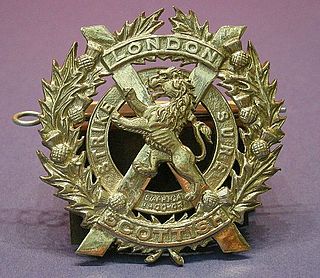
The London Scottish was a Volunteer infantry regiment of the British Army. Formerly a regiment, the unit became 'A' Company of the London Regiment.

RADA Studios is a theatrical venue in Chenies Street in the London Borough of Camden, just to the east of Tottenham Court Road, owned by the Royal Academy of Dramatic Art (RADA). The building contains rehearsal rooms and meeting rooms, and two small theatres – the 200-seat Studio Theatre, and the 50-seat Club Theatre.
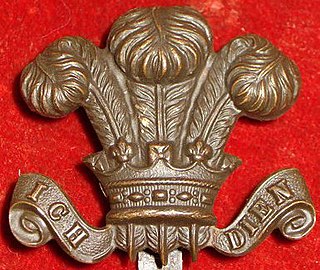
The Prince of Wales' Own Civil Service Rifles was an infantry regiment of the Volunteer Force and Territorial Force of the British Army from 1798 to 1921; it saw active service in the Boer War and World War I as part of the London Regiment.
The Volunteer Force was a citizen army of part-time rifle, artillery and engineer corps, created as a popular movement throughout the British Empire in 1859. Originally highly autonomous, the units of volunteers became increasingly integrated with the British Army after the Childers Reforms in 1881, before forming part of the Territorial Force in 1908. Most of the regiments of the present Territorial Army Infantry, Artillery, Engineers and Signals units are directly descended from Volunteer Force units.
The 9th Battalion, London Regiment was a Territorial Army infantry battalion of the British Army. The London Regiment was formed in 1908 in order to regiment the various Volunteer Force battalions in the newly formed County of London, and the Queen Victoria's Rifles were one of twenty six units brought together in this way.
The Paddington Rifles was a unit of the Territorial Army.

The 17th Battalion, The London Regiment , was a unit of Britain's Territorial Force formed in 1908 from Volunteer corps dating back to 1859. It saw considerable service on the Western Front, at Salonika and in Palestine during World War I. It served as an infantry regiment during World War II before conversion to an artillery unit in 1947 and subsequent amalgamation in 1967.

Fulham House is a military installation at 87 Fulham High Street, Fulham, London. It is a Grade II listed building.

The London Rifle Brigade was a volunteer regiment of the British Army.

The Rangers was a volunteer unit of the British Army, originally formed in 1860. It provided a detachment for service in the Second Boer War, saw intensive action on the Western Front in the First World War, and served as motorised infantry during the Second World War during the campaigns in Greece and the Western Desert.
The St Giles's and St George's Bloomsbury Rifle Volunteer Corps, more familiarly known as the Bloomsbury Rifles, was a Volunteer unit of the British Army in London from 1803 to 1814 and from 1860 until 1908.
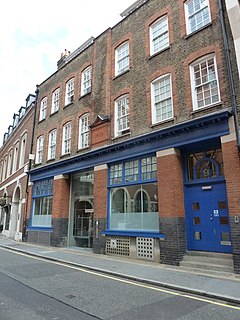
The Tufton Street drill hall is a former military installation on Tufton Street, Westminster, London.
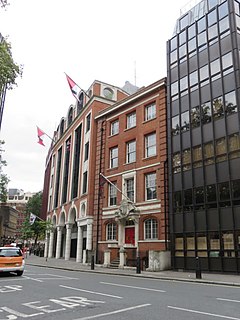
The Buckingham Gate drill halls were military installations at 58 and 59 Buckingham Gate, London.

The Priory Road drill hall is a military installation at Hornsey in London.
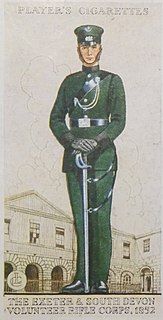
The Exeter & South Devon Volunteers was the premier unit of Britain's Volunteer Force. Formed in 1852 it went on to become a battalion of the Devonshire Regiment. Both its active service battalions went to garrison India on the outbreak of the First World War, and then saw action in Mesopotamia and Palestine. In the Second World War, the battalion served in the garrison of Gibraltar. It continued in the postwar Territorial Army until it was merged with other West Country units. Its successors today serve in a reserve battalion of The Rifles.

















